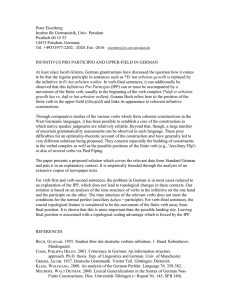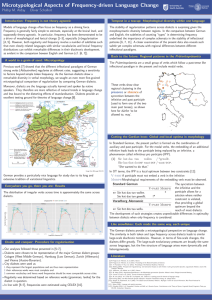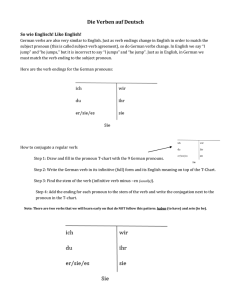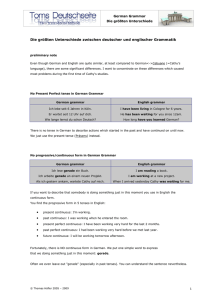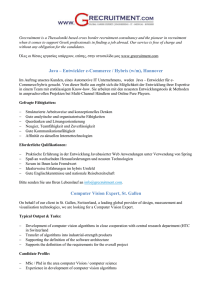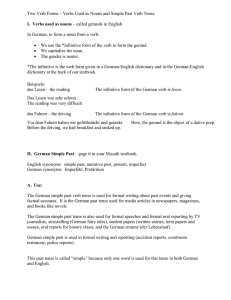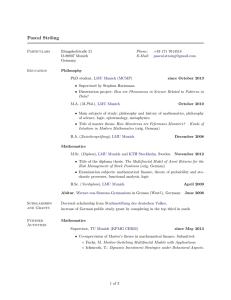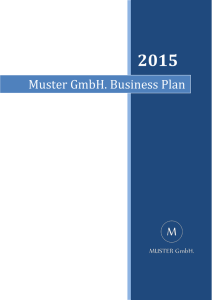1 Self repairs of finite verbs in German and Spanish
Werbung
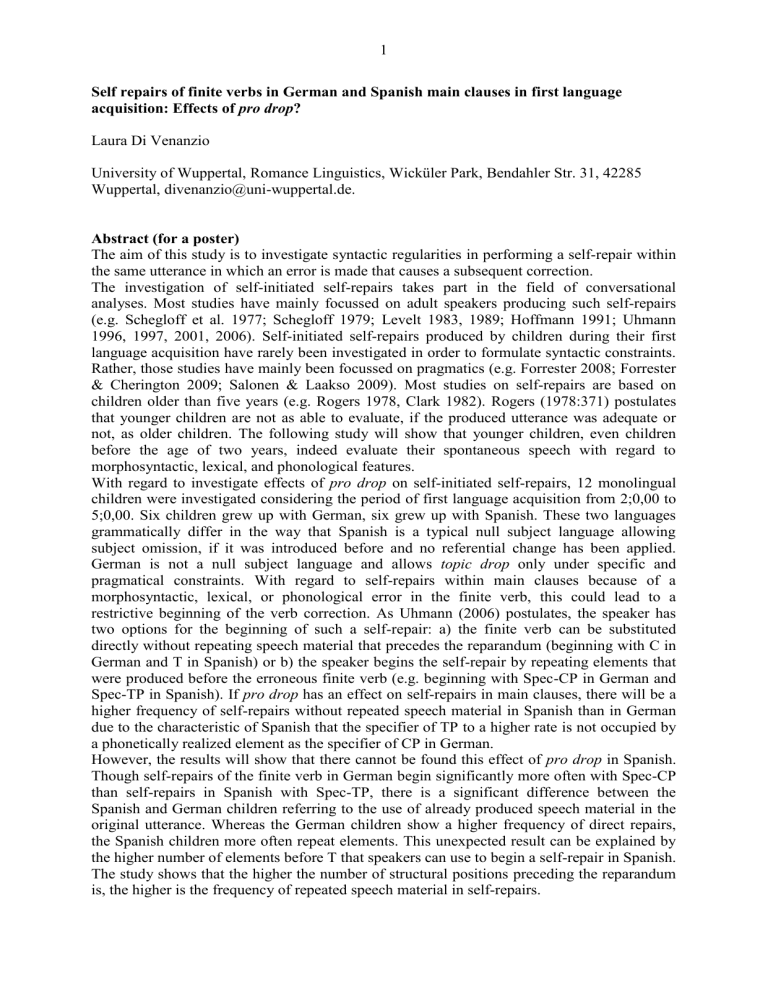
1 Self repairs of finite verbs in German and Spanish main clauses in first language acquisition: Effects of pro drop? Laura Di Venanzio University of Wuppertal, Romance Linguistics, Wicküler Park, Bendahler Str. 31, 42285 Wuppertal, [email protected]. Abstract (for a poster) The aim of this study is to investigate syntactic regularities in performing a self-repair within the same utterance in which an error is made that causes a subsequent correction. The investigation of self-initiated self-repairs takes part in the field of conversational analyses. Most studies have mainly focussed on adult speakers producing such self-repairs (e.g. Schegloff et al. 1977; Schegloff 1979; Levelt 1983, 1989; Hoffmann 1991; Uhmann 1996, 1997, 2001, 2006). Self-initiated self-repairs produced by children during their first language acquisition have rarely been investigated in order to formulate syntactic constraints. Rather, those studies have mainly been focussed on pragmatics (e.g. Forrester 2008; Forrester & Cherington 2009; Salonen & Laakso 2009). Most studies on self-repairs are based on children older than five years (e.g. Rogers 1978, Clark 1982). Rogers (1978:371) postulates that younger children are not as able to evaluate, if the produced utterance was adequate or not, as older children. The following study will show that younger children, even children before the age of two years, indeed evaluate their spontaneous speech with regard to morphosyntactic, lexical, and phonological features. With regard to investigate effects of pro drop on self-initiated self-repairs, 12 monolingual children were investigated considering the period of first language acquisition from 2;0,00 to 5;0,00. Six children grew up with German, six grew up with Spanish. These two languages grammatically differ in the way that Spanish is a typical null subject language allowing subject omission, if it was introduced before and no referential change has been applied. German is not a null subject language and allows topic drop only under specific and pragmatical constraints. With regard to self-repairs within main clauses because of a morphosyntactic, lexical, or phonological error in the finite verb, this could lead to a restrictive beginning of the verb correction. As Uhmann (2006) postulates, the speaker has two options for the beginning of such a self-repair: a) the finite verb can be substituted directly without repeating speech material that precedes the reparandum (beginning with C in German and T in Spanish) or b) the speaker begins the self-repair by repeating elements that were produced before the erroneous finite verb (e.g. beginning with Spec-CP in German and Spec-TP in Spanish). If pro drop has an effect on self-repairs in main clauses, there will be a higher frequency of self-repairs without repeated speech material in Spanish than in German due to the characteristic of Spanish that the specifier of TP to a higher rate is not occupied by a phonetically realized element as the specifier of CP in German. However, the results will show that there cannot be found this effect of pro drop in Spanish. Though self-repairs of the finite verb in German begin significantly more often with Spec-CP than self-repairs in Spanish with Spec-TP, there is a significant difference between the Spanish and German children referring to the use of already produced speech material in the original utterance. Whereas the German children show a higher frequency of direct repairs, the Spanish children more often repeat elements. This unexpected result can be explained by the higher number of elements before T that speakers can use to begin a self-repair in Spanish. The study shows that the higher the number of structural positions preceding the reparandum is, the higher is the frequency of repeated speech material in self-repairs. 2 References Clark, E. V. (1982). Language change during language acquisition. In: M. Lamb & A. Brown (eds.), Advances in developmental psychology, Vol. 2. Hillsdale, NJ: Erlbaum, 171–197. Forrester, M. A. (2008). The Emergency of Self-Repair: A Case Study of One Child During the Early Preschool Years. Research on Language and Social Interaction 41 (1), 99– 128. Forrester, M. A. & Cherington, S. M. (2009). The development of other-related conversational skills: A case study of conversational repair during the early years. First Language 29 (2), 166–191. Hoffmann, L. (1991). Anakoluth und sprachliches Wissen. Deutsche Sprache 19, 97–119. Levelt, W. J. (1983). Monitoring and self-repair in speech. Cognition 14, 41–104. Levelt, W. J. (1989). Speaking. From Intention to Articulation. Cambridge: MIT Press. Rogers, S. (1978). Self-initiated corrections in the speech of infant-school children. Journal of Child Language 5 (2), 365–371. Salonen, T. & Laakso, M. (2009). Self-repair of speech by four-year-old Finnish children. Journal of Child Language 36, 855–882. Schegloff, E. A. (1979). The relevance of repair to syntax-for-conversation. In: T. Givón (ed.), Syntax and Semantics [Volume 12: Discourse and Syntax]. New York: Academic Press, 261–286. Schegloff, E. A., Jasperson, G. & Sacks, H. (1977). The preference for self-corrections in the organization of repair in conversation. Language 53, 361–382. Uhmann, S. (1996). Warum man den Kopf nicht verlieren darf, wenn man sich selbst korrigiert. Wuppertaler Arbeitspapiere zur Sprachwissenschaft 13, 27–55. Uhmann, S. (1997). Selbstreparaturen in Alltagsdialogen: Ein Fall für eine integrative Konversationstheorie. In: P. Schlobinski (ed.), Zur Syntax des gesprochenen Deutsch. Opladen: Westdeutscher Verlag, 157–180. Uhmann, S. (2001). Some arguments for the relevance of syntax to same-sentence-self-repair in everyday German conversation. In: E. Couper-Kuhlen & M. Selting (eds.), Studies in Interactional Linguistics. Amsterdam: Benjamins, 373–404. Uhmann, S. (2006). Grammatik und Interaktion: Form follows function? - Function follows form? In: A. Deppermann, R. Fiehler & T. Spranz-Fogasy (eds.), Grammatik und Interaktion. Untersuchungen zum Zusammenhang von grammatischen Strukturen und Gesprächsprozessen. Radolfzell: Verlag für Gesprächsforschung, 179–201.

